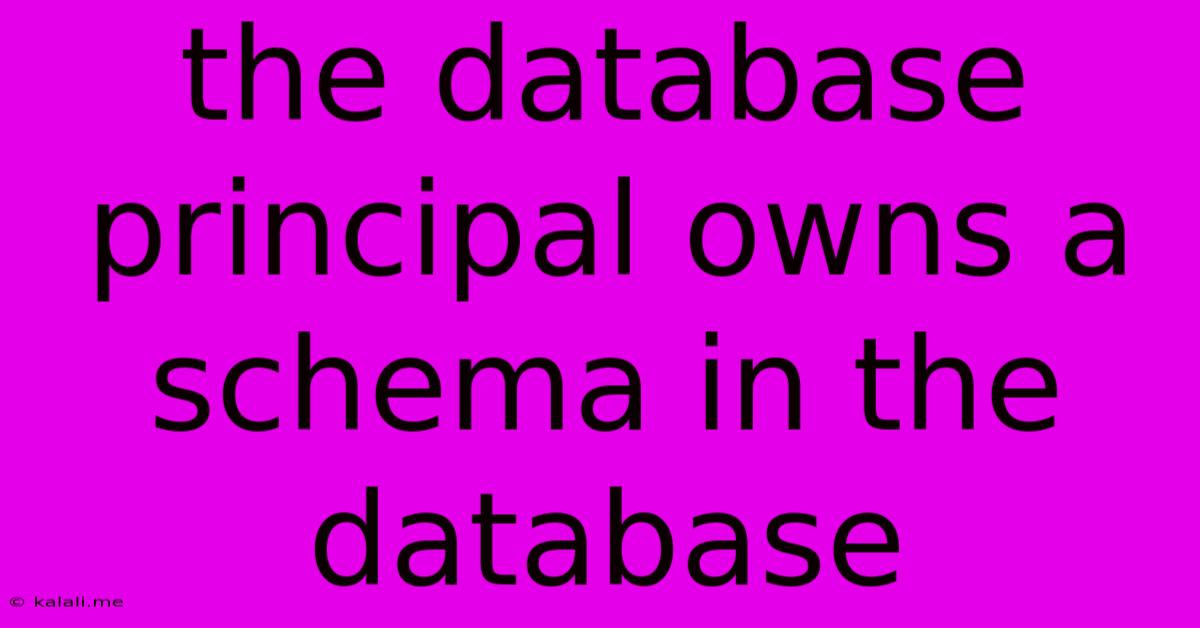The Database Principal Owns A Schema In The Database
Kalali
May 28, 2025 · 3 min read

Table of Contents
The Database Principal Owns a Schema in the Database: Understanding Ownership and Permissions
The concept of database ownership is crucial for managing security and access control within a database system. This article delves into the fundamental principle of how a database principal, typically a user or group, owns a schema and what implications this ownership holds for permissions and data management. Understanding this relationship is key to building robust and secure database applications.
In relational database management systems (RDBMS) like SQL Server, Oracle, PostgreSQL, and MySQL, schemas serve as containers for database objects such as tables, views, stored procedures, and functions. A database principal, representing a user or a group of users, can be granted ownership of a schema. This ownership grants extensive privileges and control over the objects within that schema.
Understanding Database Principals
Before diving into schema ownership, let's clarify what a database principal is. A database principal is essentially an entity that the database system authenticates and authorizes to access its resources. Common examples include:
- Users: Individual users who connect to the database.
- Groups: Collections of users that are granted permissions as a single unit.
- Roles: Predefined sets of permissions that can be assigned to users or groups. This provides a more granular and manageable approach to permission management.
The Significance of Schema Ownership
The principal who owns a schema possesses the most extensive privileges over all the objects contained within it. This includes:
- Full Control: The owner can perform any operation on any object within the schema, including creating, altering, dropping, and granting permissions. This grants complete administrative control.
- Implicit Permissions: Ownership implicitly grants all permissions—select, insert, update, delete, execute—on all objects within the schema. Other users need explicit permissions granted by the schema owner.
- Ownership Chain: Ownership creates a hierarchical structure. If a user owns a schema and that schema contains objects owned by another user, the schema owner effectively inherits control over those nested objects.
Granting and Revoking Permissions
While the schema owner has complete control, they often need to grant specific permissions to other users or groups to collaborate on database tasks. This is typically done using GRANT and REVOKE statements, which are specific to each database system, but follow similar principles.
Example (Conceptual):
Let's say a user named Jane owns the schema SalesData. She can grant SELECT permission on a table named Orders within the SalesData schema to another user, John. This allows John to query data from the Orders table, but not modify it unless further permissions are granted. Jane can later revoke these permissions if needed.
Security Implications and Best Practices
Proper schema ownership is paramount for database security. Implementing a well-defined ownership model prevents unauthorized access and modification of data. Key best practices include:
- Principle of Least Privilege: Grant only the necessary permissions to users, avoiding granting excessive privileges.
- Regular Security Audits: Periodically review and adjust permissions to ensure they remain aligned with security policies.
- Role-Based Access Control (RBAC): Employ roles to efficiently manage permissions for groups of users with similar responsibilities. This simplifies administration and enhances security.
- Separate Development and Production Schemas: Using distinct schemas for development and production environments enhances security and reduces the risk of accidental data changes in the production database.
Conclusion
Understanding schema ownership is fundamental to database administration and security. By carefully managing schema ownership and permissions, database administrators can ensure data integrity, enforce access control, and build robust and secure database applications. Remember to utilize best practices and regularly audit your permissions to maintain a secure and well-managed database environment.
Latest Posts
Latest Posts
-
Gather Ye Rosebuds While Ye May
May 30, 2025
-
Can You Bring A Laptop On Plane
May 30, 2025
-
Should I Ask Before Listing Someone As A Reference
May 30, 2025
-
Can A Dehumidifier Cool A Room
May 30, 2025
-
It Will All Come Out In The Wash
May 30, 2025
Related Post
Thank you for visiting our website which covers about The Database Principal Owns A Schema In The Database . We hope the information provided has been useful to you. Feel free to contact us if you have any questions or need further assistance. See you next time and don't miss to bookmark.